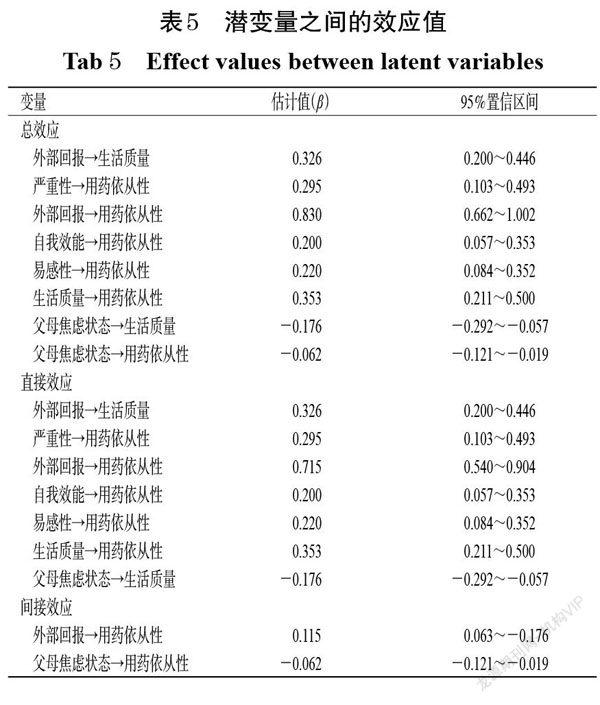基于保护动机理论的儿童抽动障碍患者用药依从性研究
杨春松 张伶俐 李佳圆 俞丹 杨亚亚 吴小芳



編者按:为深入学习贯彻习近平新时代中国特色社会主义思想,落实2021年全国宣传部长会议和全国卫生健康工作会议精神,聚焦中国共产党成立以来卫生健康事业历史进程中的重要决策、活动及成果,从不同角度和层面展现卫生健康事业发展的重要成就,我刊特从2021年7月起开设“党为人民谋健康的100年”专栏,从我刊实际出发,陆续推出一系列我国健康卫生事业与药学工作结合的相关文章,从而助力提高人民健康水平制度保障、坚持和发展中国特色卫生健康制度。本期专栏文章《基于保护动机理论的儿童抽动障碍患者用药依从性研究》以317例儿童抽动障碍患者为研究对象,以强调行为主体对行为长期认知的调节作用的“保护动机理论”作为理论基础,采用调查问卷收集患者用药依从性和相关因素数据,并采用结构方程模型分析对用药依从性有显著影响的重要因素,进而针对性地提出儿童抽动障碍患者用药管理策略,从而为改善药物治疗效果、提升医疗机构儿科医务工作者的服务水平提供参考。
中图分类号 R725.9;R971;R985 文献标志码 A 文章编号 1001-0408(2021)19-2415-06
DOI 10.6039/j.issn.1001-0408.2021.19.19
摘 要 目的:研究儿童抽动障碍(TD)患者用药依从性现状及影响因素,为改善儿童TD患者的用药依从性提供依据。方法:基于保护动机理论设计调查问卷,采用横断面调查研究方法于2018年1月-2019年12月对四川大学华西第二医院确诊的儿童TD患者进行问卷调查,并根据理论假设建立结构方程模型,采用极大似然法估计模型;对单因素分析中有显著影响的因素进行多元线性回归分析,并开展路径分析和中介效应检验。结果:共纳入317例患者,平均年龄为(8.38±2.54)岁,平均病程为(3.19±2.46)年;用药依从性平均得分为(5.70±1.69)分,其中15.1%为依从性低,37.5%为依从性中等,47.3%为依从性高。多元线性回归分析显示,有无共患病(β=0.124,SE=0.167,P=0.011)、主要监护人受教育程度(β=0.236,SE=0.110,P<0.000 1)、生活质量(β=0.399,SE=0.112,P<0.000 1)和服用药物种类(β=0.166,SE=0.047,P=0.001)是影响儿童TD患者用药依从性的影响因素。结构方程模型分析显示,严重性(β=0.295,95%置信区间:0.103~0.493)、外部回报(β=0.830,95%置信区间:0.662~1.002)、自我效能(β=0.200,95%置信区间:0.057~0.353)、易感性(β=0.220,95%置信区间:0.084~0.352)和生活质量(β=0.353,95%置信区间:0.211~0.500)对患者用药依从性均有直接的正向影响,生活质量在外部回报和依从性变量之间起中介作用(中介效应占总效应值的13.9%)。结论:儿童TD患者用药依从性不高;建议各级医疗机构的儿科医务工作者从严重性、易感性、外部回报和自我效能去管理患者的用药依从性,以提高患者及其监护人对疾病及用药不依从的严重性和易感性的认识,同时弱化外部回报和增加自我效能,最终提升患者的用药依从性。
关键词 儿童;抽动障碍;用药依从性;保护动机理论;结构方程模型;影响因素
Study on the Medication Compliance of Children with Tic Disorder Based on the Theory of Protective Motivation
YANG Chunsong1,2,ZHANG Lingli1,2,LI Jiayuan3,YU Dan4,YANG Yaya1,2,WU Xiaofang1(1. Dept. of Pharmacy, West China Second Hospital of Sichuan University/Evidence-based Pharmacy Center, Chengdu 610041, China; 2. Key Laboratory of Obstetric & Gynecologic and Pediatric Diseases and Birth Defects of Ministry of Education, Sichuan University, Chengdu 610041, China; 3. West China School of Public Health, Sichuan University/Discipline Construction Department of West China Fourth Hospital, Chengdu 610041, China; 4. Dept. of Genetics, Metabolism and Endocrinology, West China Second Hospital of Sichuan University, Chengdu 610041, China)
ABSTRACT OBJECTIVE: To study the current status and influencing factors of medication compliance in children with tic disorder (TD), and to provide reference for improving medication compliance in TD children. METHODS: The questionnaire was designed according to the protection motivation theory. The cross-sectional study was adopted to conduct questionnaire survey among TD children in West China Second Hospital of Sichuan University from Jan. 2018 to Dec. 2019. The structural equation model was established according to the theoretical assumptions, and the maximum likelihood method was used to estimate the model; multiple linear regression analysis was carried out for the factors with significant influence in the single factor analysis, and path analysis and intermediary effect test were carried out. RESULTS: A total of 317 patients with TD were included, the mean age was (8.38±2.54) years, and the mean course of disease was (3.19±2.46) years. Average medication compliance scores was (5.70±1.69), among which 15.1% was low compliance, 37.5% moderate compliance, and 47.3% high compliance. Multivariate linear regression analysis showed that comorbidities (β=0.124, SE=0.167, P=0.011), education level of the main guardian (β=0.236, SE=0.110, P<0.001), quality of life (β=0.399, SE=0.112, P<0.001) and the types of drugs taken (β=0.166, SE=0.047, P=0.001) were the factors affecting medication compliance of children with TD. Structural equation model analysis showed that severity (β=0.295,95%CI:0.103-0.493), external return (β=0.830,95%CI:0.662-1.002), self-efficacy (β=0.200,95%CI:0.057-0.353), susceptibility (β=0.220,95%CI:0.084-0.352) and quality of life (β=0.353,95%CI:0.211-0.500) had a direct positive impact on medication compliance. Quality of life mediated between external returns and compliance variables (intermediary effect accounted for 13.9% of the total effect value). CONCLUSIONS: Children with TD have low medication compliance. It is recommended that pediatricians in medical institutions at all levels to manage the medication compliance of patients with TD from the severity, susceptibility, external returns and self-efficacy, so as to improve patients and guardians awareness of the severity and susceptibility of disease and medication non-adherence, weaken external returns and increase self-efficacy, and ultimately improve medication compliance of patients.

